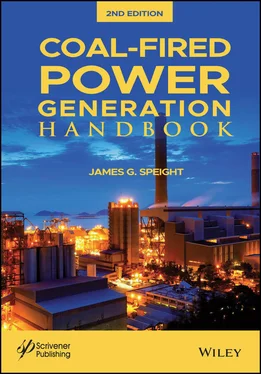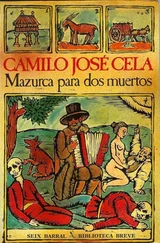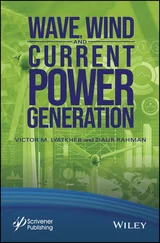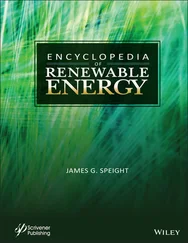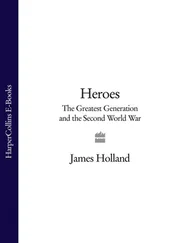The International System of coal classification came into being after the Second World War as a result of the greatly increased volume of trade between the various coal-producing and coal-consuming nations. This particular system, which still finds limited use in Europe, defines coal as two major types: hard coal and brown coal. For the purposes of the system, hard coal is defined as a coal with a calorific value greater than 10,260 Btu/lb (5700 kcal/ kg) on a moist, but ash-free basis. Conversely, brown coal is defined as coal with a calorific value less than 10,260 Btu/lb (5,700 kcal/kg). In this system, the hard coals (based on dry, ash-free volatile matter content and moist, ash-free calorific value) are divided into groups according to their caking properties ( Chapters 5, 6). These latter properties can be determined either by the free swelling test and the caking property is actually a measure of how a coal behaves when it is heated rapidly (Speight, 2013). The coal groups are then further subdivided into subgroups according to their coking properties (which may actually appear to be a paradox since the coking properties are actually a measure of how coal behaves when it is heated slowly).
Briefly, coking coal is a hard coal with a quality that allows the production of coke suitable to support a blast furnace charge. On the other hand, steam coal is all other hard coal not classified as coking coal. Also included are recovered slurries, middlings, and other low-grade coal products not further classified by type. Coal of this quality is also commonly known as thermal coal.
Table 2.7 National coal board (UK) system of coal classification.
| Class |
Volatile matter* (% w/w) |
Comments |
| 101 |
< 6.1 |
Anthracite |
|
| 102 |
3.1 - 9.0 |
| 201 |
9.1 - 13.5 |
Dry steam coal |
Low volatile steam coal |
| 202 |
13.6 - 15.0 |
|
| 203 |
15.1 - 17.0 |
Cooking steam coal |
| 204 |
17.1 - 19.5 |
|
| 206 |
19.1 - 19.5 |
Low volatile steam coal |
| 301 |
19.6 - 32.0 |
Prime cooking coal |
Medium volatile coal |
| 305 |
19.6 - 32.0 |
Mainly heat altered coal |
| 306 |
19.6 - 32.0 |
| 401 |
32.1 - 36.0 |
Very strongly coking coal |
High volatile coal |
| 402 |
> 36.0 |
| 501 |
32.1 - 36.0 |
Strongly coking coal |
| 502 |
> 36.0 |
| 601 |
32.1 - 36.0 |
Medium coking coal |
| 602 |
> 36.0 |
| 701 |
32.1 |
Weakly coking coal |
| 702 |
> 36.0 |
| 801 |
32.1 - 36.0 |
Very weakly coking coal |
| 802 |
> 36.0 |
| 901 |
32.1 - 36.0 |
Non-coking coal |
| 902 |
> 36.0 |
*Volatile matter - dry mineral matter free basis. In coal, those products, exclusive of moisture, given off as gas and vapor determined analytically.
A three-digit code number is then employed to express the coal in terms of this classification system. The first figure indicates the class of the coal, the second figure indicates the group into which the coal falls, and the third figure is the subgroup ( Table 2.8). For example, by this system a 523 coal would be a class 5 coal with a free swelling index of 2.5 to 4 and an expansion (dilatation) falling in the range 0 to 50.
Table 2.8 Classification of coal by the International System.


2.3.6 Coal as an Organic Rock
Coal, in the simplest sense, consists of vestiges of various organic compounds that were originally derived from ancient plants and have subsequently undergone changes in the molecular and physical structure during the transition to coal ( Chapter 1) (Speight, 2013 and references cited therein).
Some mention will be made of the nomenclature and terminology of the constituent parts of coal, i.e., the lithotypes, the macerals, and the microlithotypes (Stopes, 1919, 1935; Spackman, 1958; Speight, 2013). It is unnecessary to repeat this discussion except to note that this particular aspect of coal science (petrography) deals with the individual components of coal as an organic rock whereas the nomenclature, terminology, and classification systems are intended for application to the whole coal. Other general terms that are often applied to coal include (i) coal rank and (ii) coal grade, which are employed to describe the particular characteristics of coal.
The kinds of plant material from which the coal originated, the kinds of mineral inclusions, and the nature of the maturation conditions that prevailed during the metamorphosis of the plant material give rise to different coal types. The rank of a coal refers to the degree of metamorphosis; for example, coal that has undergone the most extensive change, or metamorphosis, has the highest rank (determined from the fixed carbon or heating value ( Chapters 1, 5, 6). The grade of a coal refers to the amount and kind of inorganic material (mineral matter) within the coal matrix ( Chapter 1). Sulfur-containing organic structures are, perhaps, the most significant of the non-hydrocarbon constituents because of the potential to generate sulfur dioxide during combustion.
2.3.7 A Hydrocarbon Resource
There have also been attempts to classify coal as one of the hydrocarbon-type resources of the Earth (Figure 2.3) but the term hydrocarbon is used too loosely and extremely generally since coal is not a true hydrocarbon and contains atoms (nitrogen, oxygen, and sulfur) other than carbon and hydrogen – a hydrocarbon (by the true chemical definition) contains carbon and hydrogen only (Fessenden and Fessenden, 1990). Even crude oil, despite the errors of the general nomenclature, is not an assemblage of true hydrocarbon derivatives (because of the occurrence of nitrogen-containing, oxygen-containing, sulfur-containing, and metal-containing species) (Speight, 2014).
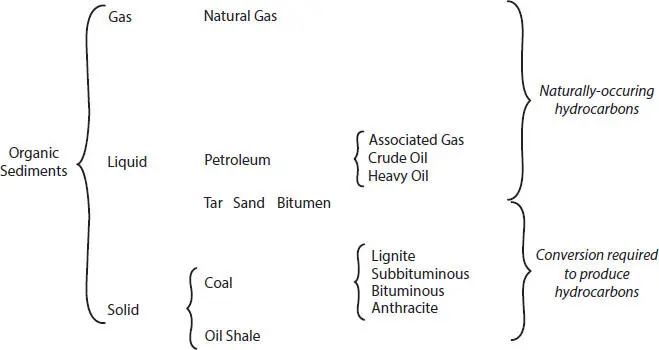
Figure 2.3Classification of the various hydrocarbon and hydrocarbon-producing resources (Speight, 2013).
Coal is an extremely complex heterogeneous material that requires several parameters for chemical and physical characterization ( Chapters 5, 6) – one single parameter is completely lacking for the true characterization of coal. However, the standard method of characterizing the organic (maceral) and the inorganic (mineral) constituents of coal is known as coal petrography (Speight, 2013 and references cited therein).
Coal petrography is the description of the components of coal as studied macroscopically and in thin and polished sections under the microscope. As the use of such methods became more common, coal petrography became concerned with the composition, structure, and origin of coals. In other words, it developed into the field of coal petrology. The principal task of coal petrology is the study of the elementary components of the organic matter of coal beds. These components are the remains of plants, which, in the process of biochemical decomposition into the peat stage of coal formation, lost or preserved to some extent their form and structure. A distinction is made here between the tissue elements and the matrix, which, taken together, constitute the components of coal. Also, macro- components, such as vitrain and fusain, are distinguished from micro-components, such as spores and cuticles.
Читать дальше
